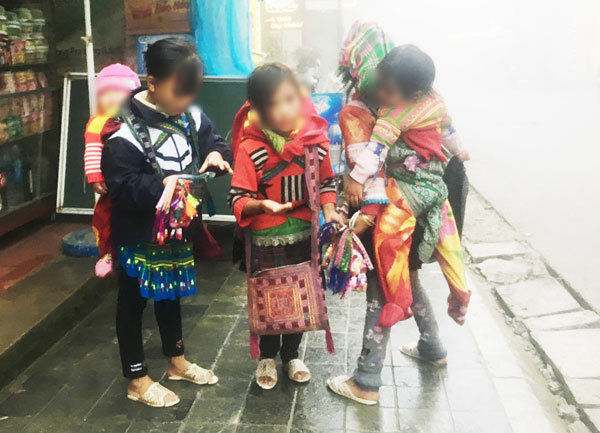 |
| Children sell souvenirs in Sapa Town, the northern mountainous province of Lao Cai. — Photo baolaocai.vn |
The event adds a voice to the global call for action on World Day against Child Labour, which falls on June 12.
Dang Hoa Nam, director of the Department of Children’s Affairs under the Ministry of Labour, Invalids and Social Affairs said that Vietnam’s first national survey of child labour in 2012 showed that there were about 1.75 million child labourers nationwide, making up 9.6 per cent of children aged between five and 17.
Child labour has significantly declined in the country as the second national child labour survey in 2018 found about 1 million labourers or 5.4 per cent of the country’s children aged between five and 17, he said.
The rate of child labour in Vietnam was now lower than the global rate of child labour – 9.6 per cent reported in 2016 and the rate in Asia and Pacific region was 7.4 per cent.
The COVID-19 pandemic left negative impacts on national socio-economic development and families' lives with an economic slowdown, increased unemployment, increased stress or domestic violence during social distancing and increasing risks of online child abuse while children spend more time on online learning, he said.
COVID-19 was projected to double the poverty rate in the country according to a report by the World Bank in April, Nam said, adding that when parents lost jobs or had their incomes reduced due to the pandemic, they tended to let children get jobs to earn some extra money for their families.
“Poverty is the biggest cause of child labour,” Nam said.
Le Hong Loan, chief of the Child Protection Section of the United Nations Children’s Fund (UNICEF) in Vietnam said that a paper “COVID-19 and child labour: A time of crisis, a time to act” released on Friday by UNICEF and the International Labour Organisation (ILO) indicated that the crisis could lead to the first recorded rise in child labour after 20 years of progress.
Since 2000, child labour globally decreased by 94 million but that gain is now at risk.
“The pandemic could result in a rise in poverty and therefore an increase in child labour as households use every available means to survive,” she said, adding that some studies show that a one percentage point rise in poverty leads to at least 0.7 per cent increase in child labour in certain countries.
During social distancing due to the pandemic, children were off school, so they went to work and then continued working rather than returning to school.
In some cases, children from poor families or in disadvantaged areas did not have equipment such as TVs, smart phones or computers to join online classes, so they quit school and went to work, Loan said.
Meanwhile, employers did not have proper legal understanding about child labour or they saw the benefit of cheap child labour and employed the children, Loan said.
The working children’s physical and mental health was seriously impacted, Loan said, mentioning the high risks of sexual abuse and human trafficking they could face.
Hoang To Linh, an expert from ILO, said the COVID-19 pandemic caused a big shock to global employment in terms of unemployment, quality of work as well as its negative impacts on vulnerable groups like migrants, informal workers, women and children.
It is reported that the COVID-19 crisis is causing an unprecedented drop-off in economic activity and working time. Global working hours fell in the first quarter of 2020 by an estimated 4.5 per cent compared to the final quarter of 2019. This adds up to approximately 130 million full-time jobs, assuming a 48-hour work week.
Global working hours in the second quarter are expected to be 10.5 per cent lower, equivalent to 305 million full-time jobs, according to the paper by UNICEF and the ILO.
Fewer employment opportunities and lower wages can drive people into informal or exploitative work, which can further suppress wages and in turn contribute to child labour.
Compared to adults, children are more likely to accept work for less pay and in vulnerable conditions.
Businesses may deliberately recruit children to cut costs and boost earnings.
In Vietnam, the ILO estimated in April that between 4.6 and 10.3 million workers may be affected by the pandemic. Of concern to UNICEF is increasing evidence that many children did not return to school when they reopened in May this year.
More than half of about one million child labourers in Vietnam are said to be in hazardous work. As the pandemic wreaks havoc on family income, those children are now at even greater risk of working longer hours or under worsening conditions.
Linh said that ILO and Vietnam’s Government were carrying out a rapid assessment on the impacts of COVID-19 on child labour, which would inform the upcoming National Plan of Action to prevent and reduce child labour for the 2021-25 period. VNS

Domestic violence reports spike amid social distancing
As Vietnam uses social distancing to slow the spread of the coronavirus, champions of women’s rights fear the policy may be putting women in greater danger of domestic violence.

Vietnam seeks to eliminate child labour
Vietnam’s deeper integration into the global economy requires the country to enhance its capacity to comply with international labour commitments, including the elimination of forced labour and child labour, experts have said.
 Children need to be protected from child labour more than ever due to the devastating impacts of the COVID-19 crisis, experts said during a virtual interactive panel discussion held in Hanoi last week." itemprop="description" />
Children need to be protected from child labour more than ever due to the devastating impacts of the COVID-19 crisis, experts said during a virtual interactive panel discussion held in Hanoi last week." itemprop="description" />